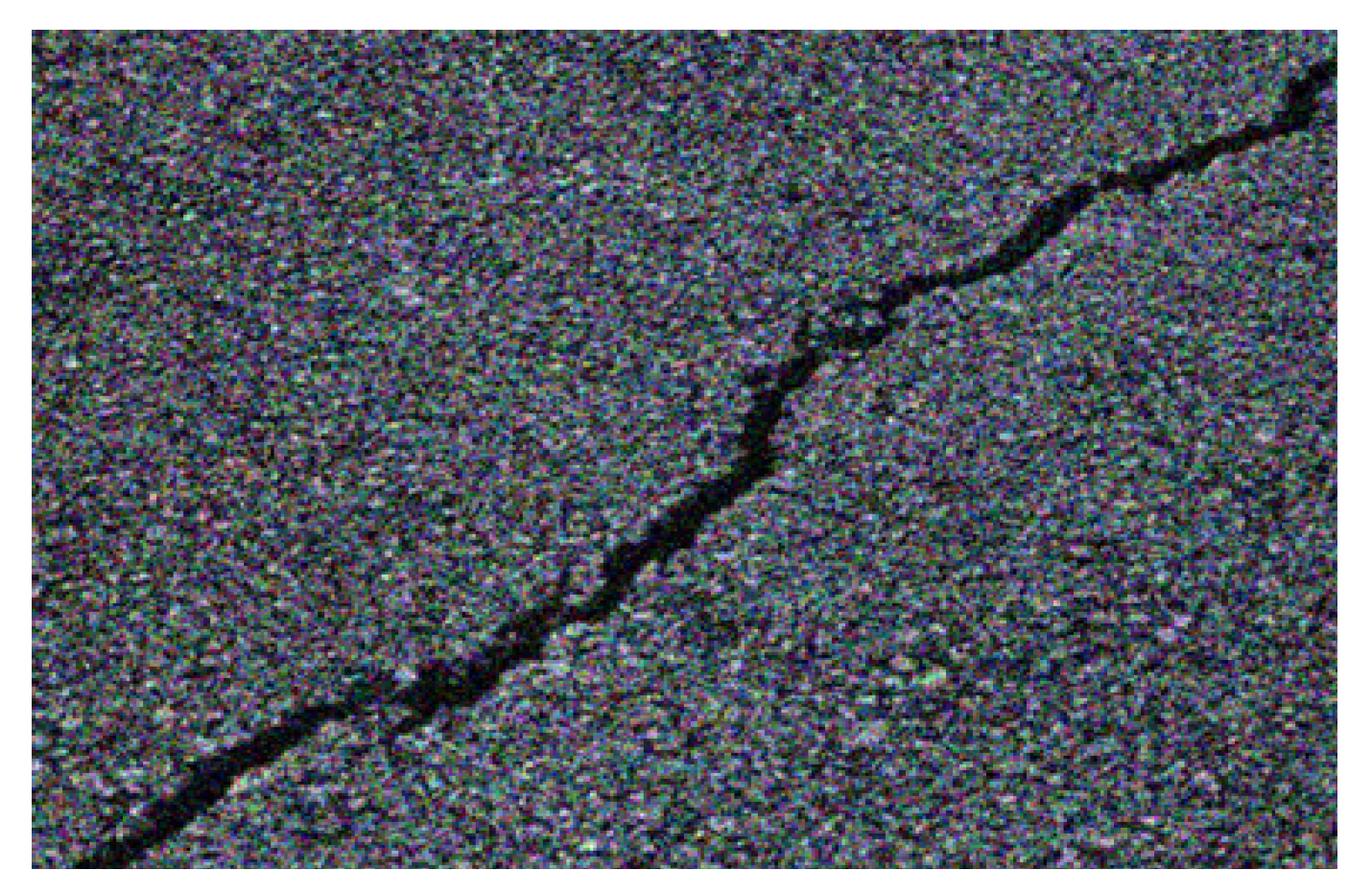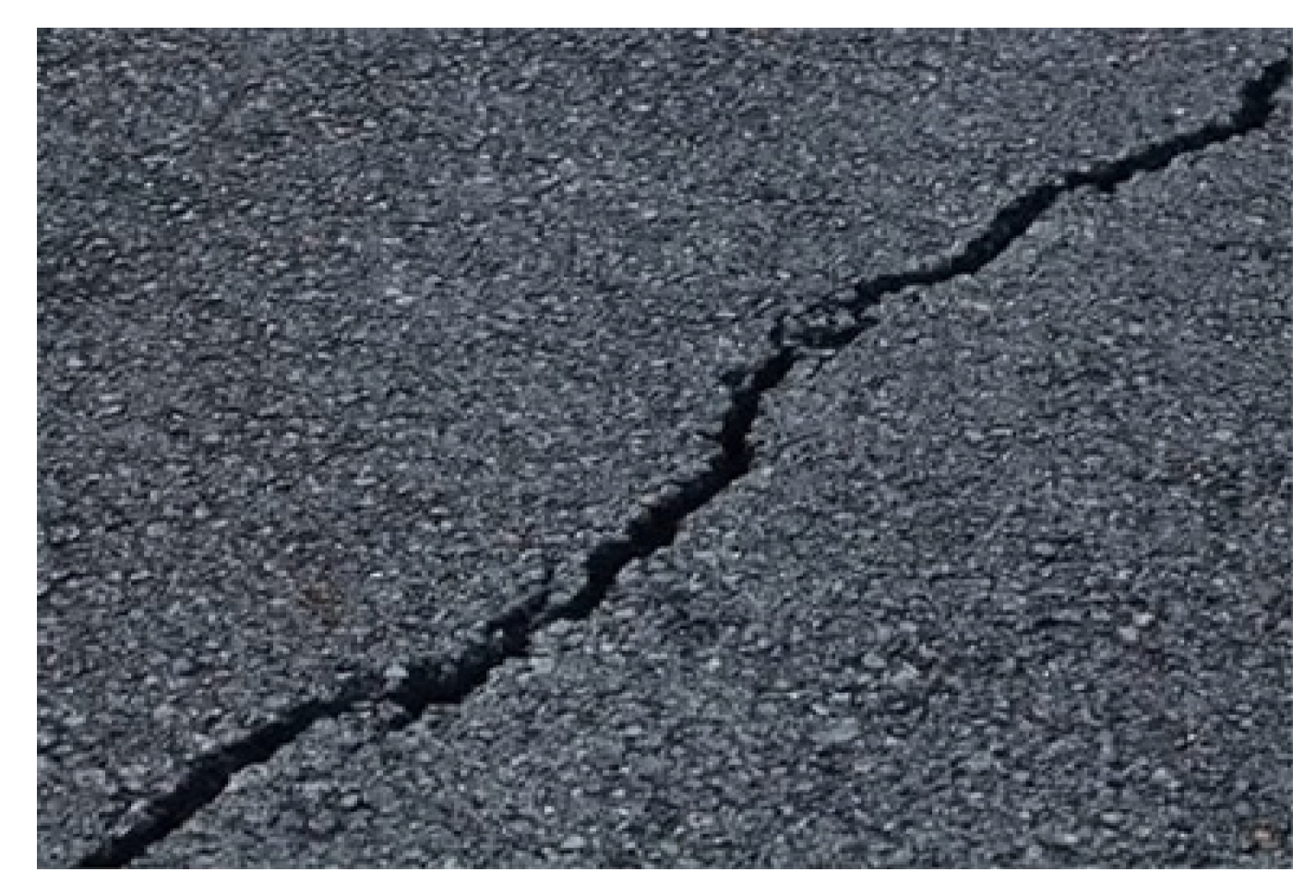An Improved Crack Identification Method for Asphalt Concrete Pavement
Abstract
:1. Introduction
2. Methodology
2.1. Image Feature Enhancement Method of Asphalt Concrete Pavement Cracks
2.1.1. Pavement Crack Image Denoising Preprocessing
2.1.2. Fractional Differential Image Feature Enhancement Algorithm Based on Image Feature Segmentation
2.2. Segmentation Processing of Crack Image Based on Watershed Algorithm
2.3. Classification and Identification Method of Cracks
2.3.1. Crack Direction Identification
2.3.2. Extraction of Crack Parameters
3. Experiment and Result Analysis
4. Conclusions
Author Contributions
Funding
Institutional Review Board Statement
Informed Consent Statement
Data Availability Statement
Conflicts of Interest
References
- The Editorial Department of People’s Transportation. Promoting high-quality development of highways. People’s Transp. 2022, 10, 10–13. [Google Scholar]
- Zhao, H.-T.; Zhou, Q.-H. Pavement crack detection based on fractional domain windowing and contrast enhanceme. Sci. Technol. Eng. 2023, 23, 347–355. [Google Scholar]
- Ma, J.; Zhao, X.-M.; He, S.-H.; Song, H.-X.; Zhao, Y.; Song, H.-S.; Cheng, L.; Wang, J.-F.; Yuan, Z.-Y.; Huang, F.-W.; et al. Review on Pavement detection technology. J. Traffic Transp. Eng. 2017, 17, 121–137. [Google Scholar]
- Hao, J.-M.; Yang, J.-Y.; Han, S.-M.; Wang, Y.-P. YOLOv4 highway pavement crack detection method using Ghost module and ECA. J. Comput. Appl. 2023, 43, 1284–1290. [Google Scholar]
- Winkelmaier, G.; Battulwar, R.; Khoshdeli, M.; Valencia, J.; Sattarvand, J.; Parvin, B. Topographically guided uav for identifying tension cracks using image-based analytics in open-pit mines. IEEE Trans. Ind. Electron. 2021, 68, 5415–5424. [Google Scholar] [CrossRef]
- Palermo, F.; Ardila, L.; Oh, C.; Althoefer, K.; Poslad, S.; Venture, G.; Farkhatdinov, I. Multi-modal robotic visual-tactile localisation and detection of surface cracks. In Proceedings of the IEEE International Conference on Automation Science and Engineering (CASE), Lyon, France, 23–27 August 2021; Volume 21, pp. 23–27. [Google Scholar]
- Mubashshira, S.; Azam, M.; Ahsan, S. An Unsupervised Approach for Road Surface Crack Detection. In Proceedings of the 2020 IEEE Region 10 Symposium (TENSYMP), Dhaka, Bangladesh, 5–7 June 2020; Volume 20, pp. 1596–1599. [Google Scholar]
- Wang, R.; Qiong, L. Application research of attribute fusion technology based on principal component analysis in fracture identification. IOP Conf. Ser. Earth Environ. Sci. 2021, 671, 12–18. [Google Scholar] [CrossRef]
- Vega, B.; Kovscek, A. Fractal characterization of multimodal, multiscale images of shale rock fracture networks. Energies 2022, 15, 1012. [Google Scholar] [CrossRef]
- Wei, H.-B.; Wu, S.-W.; Zhang, Q.-F.; Wang, C.-Z.; Zhu, H.-D.; Qiang, D.-J. Research on asphalt pavement crack recognition algorithm based on image processing. J. China Foreign Highw. 2020, 40, 73–78. [Google Scholar]
- Xiao, L.-Y.; Li, W.-D.; Huyan, J.; Sun, Z.-Y.; Tighe, S. Crack grid detection and calculation based on convolutional neural network. Can. J. Civ. Eng. 2021, 48, 1192–1205. [Google Scholar] [CrossRef]
- Wang, W.-X.; Wang, M.-F.; Li, H.-X.; Zhao, H.; Wang, K.; He, C.-T.; Wang, J.; Zheng, S.-F.; Chen, J.-B. Pavement crack image acquisition methods and crack extraction algorithms: A review. J. Traffic Transp. Eng. Engl. Ed. 2019, 6, 535–556. [Google Scholar] [CrossRef]
- Qu, Z.; Chen, W.; Wang, S.-Y.; Yi, T.M.; Liu, L. A Crack Detection Algorithm for Concrete Pavement Based on Attention Mechanism and Multi-Features Fusion. IEEE Trans. Intell. Transp. Syst. 2022, 23, 11710–11719. [Google Scholar] [CrossRef]
- Zhang, X.-F.; Yan, H. Image enhancement algorithm using adaptive fractional differential mask technique. Math. Found. Comput. 2019, 2, 347–359. [Google Scholar] [CrossRef] [Green Version]
- Wang, G.-Q.; Zhou, X.-H.; Yu, L.-L. Image Segmentation Based on Watershed Algorithm. Comput. Simul. 2009, 26, 255–258. [Google Scholar] [CrossRef]
- Zhang, X.-Y.; Liu, Z.-X.; Zhu, Z.-J. An Image Segmentation Method Based on Improved Watershed Algorithm. J. Air Force Eng. Univ. Nat. Sci. Ed. 2010, 11, 56–59. [Google Scholar]
- Indriyani, T.; Utoyo, M.; Rulaningtyas, R. A New Watershed Algorithm for Pothole Image Segmentation. Stud. Inform. Control. 2021, 30, 131–139. [Google Scholar] [CrossRef]
- Song, Y.-H.; Yan, H. Image Segmentation Techniques Overview. In Proceedings of the 2017 Asia Modelling Symposium (AMS), Kota Kinabalu, Malaysia, 4–6 December 2017; pp. 103–107. [Google Scholar]
- Qin, G.-F.; Huang, L.-Y.; Yang, S. Classification of pavement crack types based on square bounding box diagonal matching method. Neural Comput. Appl. 2022, 34, 13125–13132. [Google Scholar] [CrossRef]
- Song, W.-D.; Jia, G.-H.; Jia, D.; Zhu, H. Automatic Pavement Crack Detection and Classification Using Multiscale Feature Attention Network. IEEE Access 2019, 7, 171001–171012. [Google Scholar] [CrossRef]
- Tsai, Y.; Jiang, C.-L.; Huang, Y.-C. Multiscale Crack Fundamental Element Model for Real-World Pavement Crack Classification. J. Comput. Civ. Eng. 2014, 28, 04014012. [Google Scholar] [CrossRef]
- Tong, Z.; Gao, J.; Han, Z.-Q.; Wang, Z.-J. Recognition of asphalt pavement crack length using deep convolutional neural networks. Road Mater. Pavement Des. 2018, 19, 1334–1349. [Google Scholar] [CrossRef]
- Yang, Q.; Deng, Y.-J. Evaluation of cracking in asphalt pavement with stabilized base course based on statistical pattern recognition. Int. J. Pavement Eng. 2019, 20, 417–424. [Google Scholar] [CrossRef]




| Image Sequence Number | Original | Image after Feature Enhancement |
|---|---|---|
| 1 | 5.82 | 7.03 |
| 2 | 4.79 | 6.46 |
| 3 | 5.17 | 7.15 |
| 4 | 6.04 | 7.99 |
| 5 | 5.59 | 6.79 |
| 6 | 5.61 | 5.99 |
| 7 | 6.33 | 7.18 |
| 8 | 6.52 | 7.24 |
| 9 | 6.49 | 7.81 |
| 10 | 5.87 | 7.07 |
| 11 | 5.55 | 7.19 |
| Image Sequence Number | Linear Cracks | Net-Shaped Cracks | Is It Correctly Identified? | |
|---|---|---|---|---|
| Transverse Crack | Longitudinal Crack | |||
| 1 | √ | correct | ||
| 2 | √ | correct | ||
| 3 | √ | correct | ||
| 4 | √ | correct | ||
| 5 | √ | correct | ||
| 6 | √ | correct | ||
| 7 | √ | correct | ||
| 8 | √ | correct | ||
| 9 | √ | correct | ||
| 10 | √ | correct | ||
| Image Sequence Number | Original Length | Original Width | Length | Width | Maximum Length Deviation | Maximum Width Deviation |
|---|---|---|---|---|---|---|
| 1 | 50.47 | 8.68 | 50.19 | 8.56 | 0.28 | 0.12 |
| 2 | 103.46 | 15.86 | 103.27 | 15.78 | 0.19 | 0.08 |
| 3 | 24.91 | 2.22 | 24.55 | 2.01 | 0.36 | 0.21 |
| 4 | 11.37 | 1.44 | 10.9 | 1.15 | 0.47 | 0.29 |
| 5 | 84.57 | 5.41 | 84.25 | 5.17 | 0.32 | 0.24 |
| 6 | 41.88 | 4.27 | 41.66 | 3.96 | 0.22 | 0.31 |
| 7 | 134.71 | 21.68 | 134.52 | 21.57 | 0.19 | 0.11 |
| 8 | 101.34 | 26.98 | 101.16 | 26.85 | 0.18 | 0.13 |
| 9 | 85.36 | 15.77 | 85.21 | 15.66 | 0.15 | 0.11 |
| 10 | 84.16 | 7.48 | 83.94 | 7.29 | 0.22 | 0.19 |
Disclaimer/Publisher’s Note: The statements, opinions and data contained in all publications are solely those of the individual author(s) and contributor(s) and not of MDPI and/or the editor(s). MDPI and/or the editor(s) disclaim responsibility for any injury to people or property resulting from any ideas, methods, instructions or products referred to in the content. |
© 2023 by the authors. Licensee MDPI, Basel, Switzerland. This article is an open access article distributed under the terms and conditions of the Creative Commons Attribution (CC BY) license (https://creativecommons.org/licenses/by/4.0/).
Share and Cite
Li, Y.; Yang, N. An Improved Crack Identification Method for Asphalt Concrete Pavement. Appl. Sci. 2023, 13, 8696. https://doi.org/10.3390/app13158696
Li Y, Yang N. An Improved Crack Identification Method for Asphalt Concrete Pavement. Applied Sciences. 2023; 13(15):8696. https://doi.org/10.3390/app13158696
Chicago/Turabian StyleLi, Yongshang, and Nan Yang. 2023. "An Improved Crack Identification Method for Asphalt Concrete Pavement" Applied Sciences 13, no. 15: 8696. https://doi.org/10.3390/app13158696






